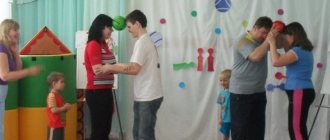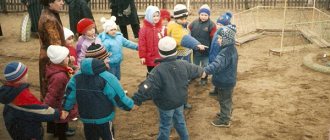Holiday "Magpies" for preschool children of the preparatory group of preschool educational institutions
Scenario for the spring celebration “Magpies” for children of senior preschool age
Prepared by : Posevkina Natalya Nikolaevna Place of work and position: teacher of additional education at the district Children's Art Center in the city of Korablino, Ryazan region Description: the script is intended for children of the preparatory group of a kindergarten studying “Fundamentals of Orthodox Culture” . Parents of children are invited to the celebration. Goal: to expand children’s understanding of Orthodox holidays and introduce them to folk culture. Objectives: -give children an idea of the traditions of celebrating spring; -introduce folk signs associated with spring, teach how to observe plants and animals; -continue to introduce children to folk games, develop dexterity and coordination of movements. Progress of the holiday: 1. Meeting the guests, music videos on multimedia 2. A story about the Orthodox holiday “Magpies”.
Presentation. Opening words by the presenter: Dear guests! Today we will celebrate an ancient and very beloved holiday among the people. It is called “Magpies” (from the number “forty”). This is the day of remembrance of forty martyrs - soldiers who suffered for their faith. Show presentation. Presentation on the topic: Magpies
3. Performance of children performing spring chants 4. Congratulations to the birthday people. Every Orthodox Christian bears the name of the saint after whom he is named. The name is chosen according to the church calendar, each day of which is dedicated to the memory of a particular saint. Today, on the day of remembrance of the forty Martyrs of Sebaste, many boys also celebrate their name days. These are: Alexander, Alexey, Afanasy, Valery, Dmitry, Ivan, Irakli, Kirill, Leonty, Mikhail, Nikolay, Peter, Sergey, Taras. Raise your hands whose names I mentioned! Children raise their hands and receive from the presenter rag birds made without sewing. 5. Presenter: Now let’s dance, let’s stand in a round dance to Russian folk music! (Round dance with ribbons and handkerchiefs)
6. Game “Larks in Nests” (Props: hoops)
Now we will play the game “Larks in Nests”. Do you know which larks make nests? Larks make nests on the ground, in holes. They are lined with grass, feathers, and horsehair. (the presenter puts hoops of different colors: yellow, green, blue on the floor) - now you will be birds, and these are your nests. Three or four children occupy the hoops. - Remember what color your nest is. When the music starts, the larks fly away from the nest. When the music ends, you need to take your nest. Be careful. 7. Children sit on chairs. Riddles about spring on multimedia for children. Children solve riddles in unison. 8. And now a task for the parents who came to visit us. Let parents guess Russian folk proverbs associated with spring. (On multimedia) 9. But the next task can be done by everyone together: you need to guess the voices of the birds. “The bird rejoices in spring,” people said. It must be said that Russian people have long treated birds with special affection and love. (The voices of a cuckoo, a woodpecker, a nightingale, a lark, and a rook are heard on the multimedia) Children and parents guess. 10. During the holiday, both adults and children went outside and played fun games. Game "Stream" to music. 11. Folk game “Carousel”: Children stand in a circle and, at the leader’s signal, they all say together: “Barely, barely, barely. The carousel spun, And then around, around, Everyone ran, ran, ran.” In accordance with the text, children walk in a circle, first slowly, and then gradually speed up their movements. After the children have run two circles, they gradually switch to walking, saying: Hush, hush, don’t rush! Stop the carousel! One-two, one-two! The game is over! " The movement of the carousel slows down, the children lower their hands; The game is repeated, the children move in a circle in the other direction.
12. In ancient times in Rus' they loved and looked forward to the feast of the Forty Martyrs of Sebaste and prepared for it. At this time, migratory birds were already beginning to return to their homeland. On this day, in every house they made these birds from dough (shows) - larks, and baked them. Those who did not have dough sculpted them from clay, made them from rags and paper. In the old days, people believed that spring comes because birds bring it from distant lands. They gave the children “birds” and said: “When the larks come, bring spring.” Baked larks were seated on thawed patches, roofs, trees and haystacks, and spring was called out with them. Plus, they are very tasty. 13. Treating children and parents with larks.
Presentation on the topic: Riddles about spring for children
We recommend watching:
Scenario of a folklore festival for children of senior preschool age (5-7 years old) on the topic: Spring Scenario of a spring performance for children of the preparatory group in kindergarten Musical fairy tale on the topic: Spring for children of the preparatory group of kindergarten Scenario of a spring gala concert for senior preschool children
Similar articles:
Spring games for children in kindergarten. Senior preparatory group
Spring fairy tale. Scenario for the preparatory group
Spring entertainment for older children in kindergartens. Snowdrop
Physical education leisure in the senior group in the spring. Abstract
Spring fun for older preschoolers. Scenario
Spring Bird Festival
The Magpies holiday is celebrated according to the folk calendar of the Eastern Slavs on March 22, the day of the spring equinox. The very name of the holiday is associated with the day of remembrance of the forty Sebastian martyrs, celebrated by the Orthodox Church.
However, holiday ceremonies and rituals are not associated with this event, but with the belief that it is on this day that the first migratory birds - larks and waders - return home. They bring spring with them and open the way for all other birds returning from wintering in warmer climes. The spring equinox is the day when winter ends and spring begins; day and night are equal.
The holiday was popularly called differently: “Magpies”, “Larks”, “Waders”, “Teterochny Day”. The last name is associated, however, not with birds, but with a special type of ritual cookies - tethers, made on the day of the spring solstice in the northern regions of Rus'. They have a round twisted shape as they symbolize the sun.
The tradition of baking dough products in the shape of the sun or birds for the Magpies holiday was widespread throughout the country. They were called “larks”, “magpies”, “waders”.
The Magpies holiday is a children's holiday
This is great fun for kids. By celebrating the Magpies holiday in kindergarten in March, teachers give children the opportunity to plunge into the atmosphere of ancient traditions, get acquainted with Orthodox customs, and take part in inviting spring. During the preparation process, children are told about the holiday and rituals. They learn to make birds from paper and plasticine. Teachers teach children ritual songs, rhymes and sayings, and introduce them to ancient folk games. Children gain knowledge about the history of their country, the traditions of the Russian people, and get acquainted with the names of birds and natural phenomena.
How can you celebrate a holiday in kindergarten?
In kindergartens where the Magpies holiday is held, the script includes a story from the presenters about the signs of the coming spring, natural phenomena, and migratory birds. During the story, children become familiar with sayings related to the change of seasons, for example: “In March, the frost is creaking, but not burning,” “Spring is red during the day,” “Winter scares spring, but it itself melts.” The presenters, dressed in folk costumes, tell the children about how they prepared for the holiday in Russian villages: they baked “larks” and taught spring songs.
The children are invited to take part in the invocation of spring themselves. Children dance in a circle, recite rhymes, and sing songs. Elements of Russian festive costume can be used in children's clothing. One of the stages of the holiday is decorating the ritual tree with silk and paper ribbons and flowers.
Children are given dough birds. They are baked in advance in the kitchen or children prepare them at home with their parents. After singing the chant songs, new characters appear - “Spring” and “Sun”. Together with the children, they take part in ritual folk games and dance in circles. During the game, children name the birds they know and solve riddles. Outdoor games involve moving in a circle performing various actions, running, jumping. Among the folk games associated with the traditions of welcoming the arrival of spring, one can name “Burn, Burn Clear”, “Stream”, the round dance game “Sparrow”, “Birdcatcher”. The holiday ends with tea and sweet treats.
The Magpies holiday helps children and their parents not to forget the traditions of their people, awakens interest in Russian folklore, ancient traditions, and gives a good mood.
Forty Forty
The folk Christian holiday of Soro Sorokov is celebrated on March 22. The signs of this day were used to judge the weather for the next forty days. In the folk month, the date was called Magpies, Forty Forty, Larks, Equinox, Sorochiny, Forty Martyrs.
On this day, the Orthodox Church honors the memory of forty Christian soldiers who accepted martyrdom for their faith in Christ under Emperor Licinius in 320 in the city of Sebastia. The men refused to make sacrifices to the pagan gods, after which they were stripped and taken to an ice-covered lake, leaving them overnight. Not far from the lake there was a warm bathhouse so that those who wanted to renounce their faith could warm up in it. In the morning, one of the warriors, unable to bear the torment, ran to the bathhouse, but upon crossing its threshold he immediately died.
Seeing the steadfastness of the soldiers, one of the Romans undressed himself and joined them. The next day, the bodies of the frozen martyrs were burned and their remains were thrown into the river. Later, the brothers in faith collected the remains of the martyrs and buried them with honors.
Traditions and rituals on March 22:
The second meeting of spring is in Soroca. The peasants came out to “call” spring. This ritual was accompanied by spring songs. People used to say about this day: “For 40 martyrs, 40 birds fly.” “On Soroka, day and night are measured, winter ends, spring begins.” It is believed that on this day larks fly from across the sea.
Back on March 22, they commemorated the dead: they visited graves, ordered a mass or commemoration at a proskomedia for their relatives and friends. They did not forget to remember the deceased during meals. Women prayed to the forty martyrs so that their husband or son would return safe and sound from the war.
In Rus', on March 22, figurines of larks and 40 nut balls were baked from oatmeal or rye flour. Starting from that day, they threw one “nut” into the street every day, calling: “Frost, Red Nose! Here's your bread and oats! Now go away and say hello!” The feeding of frost for forty days is associated with the sign that after March 22 there may be another 40 night frosts.
Folk sayings and signs on March 22:
- Magpies are a holiday of the coming spring: on this day forty birds arrive.
- If it’s warm on Soroka, it will last for another forty days, and if it’s cold, expect forty cold morning frosts.
— The warm wind on this day promises a rainy summer.
— The first thunder over a bare forest is a harbinger of famine.
- In the old days in Rus' they baked larks and Easter cakes on this day.
— Women traditionally prayed to the Forty Martyrs for their husband or son to return from the war.
- If matinees continue constantly from this day forward, there will be a warm summer.
- If frost hits the Forty Saints, it means there will be a good harvest of millet.
— Buckwheat should be sown after forty frosts after the Forty Martyrs.
— On Soroki, peasant women baked forty balls from rye or oatmeal flour - “forty saints - golden colobans.”
Name day March 22:
Aglaius, Aetius, Akakios, Alexander, Alexandra, Alexey, Angius, Athanasius, Vivian, Gaius, Gorgonius, Dmitry, Dometian, Domnus, Eunoikos, Eutyches, Ekdikios, Ivan, Ilian, Elijah, Joasaph, Heraclius, Hesychius, Candide, Caesarea, Cyril, Kirion, Claudius, Xanthius, Leontius, Lysimachus, Meliton, Michael, Natalia, Nicholas, Peter, Priscus, Sakerdon, Severian, Sergei, Sisinius, Smaragd, Tarasius, Ualens (Valens), Ualery (Valery), Urpasian, Theodulus, Flavius, Theophilus, Philoctimon, Hudion
Goals:
- To awaken in children an interest in Russian folklore, in the rich world of human emotions associated with the old traditional way of life.
- To develop in children an emotional response to the spring manifestations of nature; aesthetic feelings, experiences; Creative skills.
- Foster hospitality, the desire to be kind and generous; respectful attitude towards Russian folk art; traditions and customs of the people.
- Expand children's ideas about life in the old days.
- To introduce the customs, traditions, and holidays of the Russian people; games and entertainment during the holidays.
- Continue to introduce works of small oral folklore: chants, jokes, songs, proverbs, sayings.
- Teach to understand the meaning of proverbs and sayings, encouraging the desire to explore them.
- Create a festive mood in children when communicating with Russian folklore; intensify cognitive activity.
- Evoke an emotional response to vivid folk images.
- Show the relationship between the oral, visual and musical arts.
Rituals of the holiday "Magpies"
The Magpies holiday was considered for children. Children took an active part in making ritual baked goods. Children and youth were given the main role in performing festive rituals. They had to call on spring, call upon it. With baked birds in their hands, the children ran into the field and began to invite the larks and spring. For this there were special poems and spring songs. Children, girls and boys danced in circles, sang, and played folk games.
According to tradition, it was necessary to decorate the ritual tree with ribbons, paper flowers, and bells. It was carried throughout the village, and then installed in the place where the invocation of spring was held. The holiday is associated with many different signs and fortune telling that determine the weather at the beginning of spring, the beginning of field work, and happiness in family life.
In some regions of Russia, traditions are carefully preserved, and residents of villages and villages celebrate the arrival of spring, welcoming it with songs, round dances, and chants.





